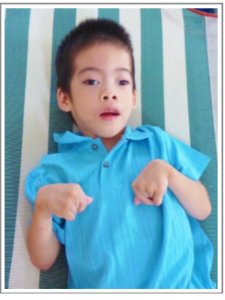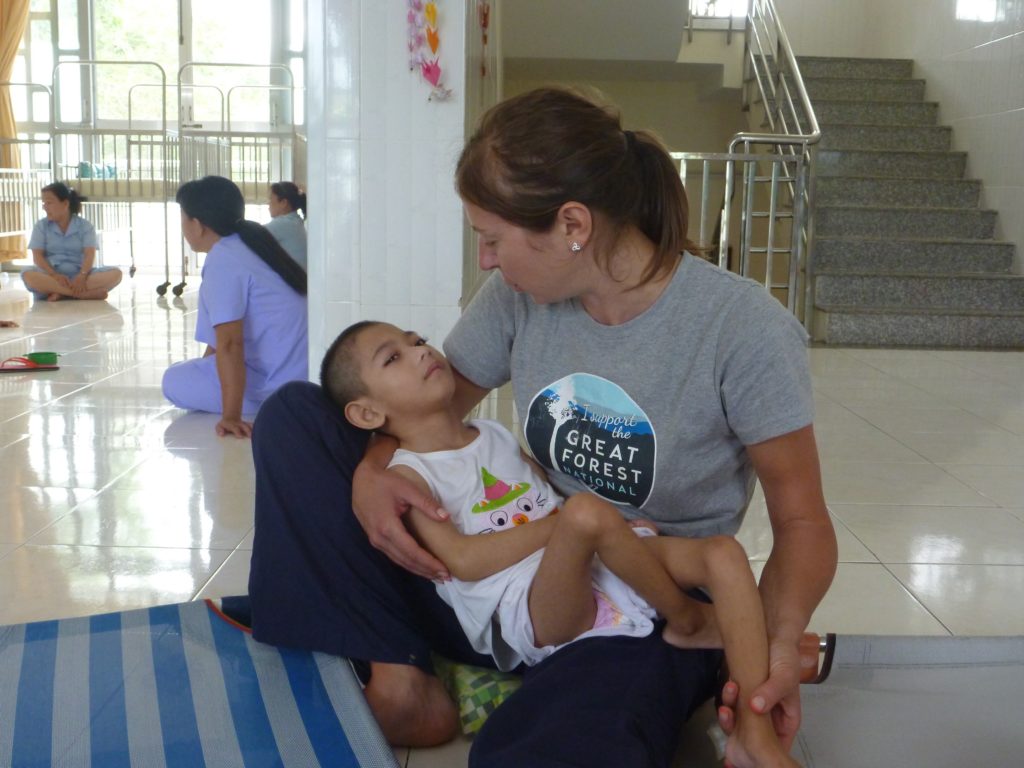Massage for children with contractures

Last year I joined the group of pediatric massage volunteers Buds To Blossoms. We traveled to Vietnam to provide gentle massage to orphans with disabilities.
We visited orphanages around Ho Chi Minh city and met children with hiv/aids, brain damage and contracted limbs. Their life is so much different from the way we live and I started to write short notes about these boys and girls to share with everyone another life we don’t know about.
I had already posted some of the stories about children with contracted limbs so now I’m presenting a short article about what contracture is, what are management and preventions and how important massage is for children suffering from the condition. You will also find massage sequence and stretches for contracted limbs with the list of references at the end. Additionally, you can donate to help with organasing future visits to the orphanages.
What is contracture?
Contracture is ‘shortened connective tissue, usually around a joint, formed after prolonged immobility … muscles become hardened, static, and shortened, and the surrounding joint either has severely limited motion or can no longer move at all’ Versagi and Woods (2012, p. 260).
Marybetts (2005) describes contracture as the lack of complete active or passive range of motion due to limitation of joint, muscle or soft tissue. Children with muscle weakness, chronic pain, cerebral palsy, paralysis experience limited mobility that results in decrease of circulation, atrophy or overuse certain muscles that may lead to developing of contractures.
When the condition progresses over time, bones might not cope with weight and bone decalcification may start: bones become weak and fragile, prone to fracture even from a minor force. Main symptom of decalcification is pain felt along the affected bones.
‘Children may become stiffer and more limited in their ability to move freely’ Marybetts (2005, p.152).
What causes contractures?
Marybetts (2005) describes the following causes of the contractures:
- when joints aren’t regularly moved through their normal range of motion, contractures may develop;
- children who are immobilized are in high risk of contractures being developed;
- in extended sitting position children prone to slump forward, loose cervical and lumbar curves, increase kyphosis; as many joints stay in constant flexion, contractures occur, especially in weak or spastic muscles;
Versagi and Woods (2012, p. 260) suggest the following causes of the contractures:
- ‘unrelenting muscle spasm, fibrosis, sustained loss of muscle balance, muscle paralysis’
What Is Contracture? – Definition, Symptoms & Treatment lists the following causes:
- ‘brain and nervous system disorders, such as cerebral palsy, stroke, polio …
- … muscular dystrophy;
- nerve damage, scarring from trauma (injury of burn), inflammation disorders (rheumatoid arthritis)’;
- one of the causes of contractures is Parkinson’s Disease, which is usually diagnosed in older patients;
Contracted tissue has a significantly different feel from extremely hypertonic tissue
How to prevent and manage contractures?
‘Effective measures, such as massage and stretches may help reduce further contracture, and/or bring pain relieve to the contracted area’ Versagi and Woods (2012, p. 260)
‘When working with immobilized children, it is important that attention be paid to joint range of motion. To prevent contractures, it is important to regularly position children in a way that stretches their affected part and do full range of motion’ Marybetts (2005, 179).
Asking permission and respecting the answer.
Before beginning to massage a child, the therapist has to ask permission.
According to Allen (2013), asking permission is the most important element in massage for children and the reasons for this are as follows:
- it gives child the choice and begins to establish positive boundaries: the child will learn what the good touch is and how the good touch should start so child is able to see a difference between good touch and touch that may not be good or positive in the future;
- shows respect for the child: children who learnt positive views of touch, are more likely to grow into adults with health self esteem, a sense of their boundaries and increased self trust;
- the distinct permission process plays role of a specific signal or cue to indicate what will happen next and provides the child with time to evaluate how they are feeling before they reply;
- gives the massage therapist an opportunity to check in, make eye contact, observe cues such as child face expression and non-verbal language;
Benefits of massage for contractures.
- massage provides the required extra stimulation to the muscles, joints, blood vessels, nerves and other affected tissues so they receive extra information and increased activity;
- during the massage the immobilized children or children who lay on cots all day may enjoy and benefit from being placed in the unusual for them positions or even just turned onto their back or side or being helped to sit up during the treatment, which might stretch or stimulate tissues that had not been challenged for a long time and can increase their range of motion;
- massage can decrease abdominal muscles tension, resulting in constipation or can decrease facial muscles tension that results in misaligned teeth;
- massage stimulates deeper breathing, bringing relaxation and relieve from stress and anxiety;
Massage sequence for children with contractures
‘Children massage doesn’t have to be complicated, aggressive or deep to be effective’ Allen (2013, p. 30). Tina Allen (2013, p.30) has developed the children’s massage technique that consist of several strokes and can be applied for the whole body by adapting the size and shape of the strokes to best fit the region on which work has to be done. The author also suggests to use child friendly and age appropriate stories, songs, rhymes and movement games that would help to establish connection between the therapist and a child both verbally and non-verbally.
Marybetts (2005) recommends to provide massage first so it will loosen the area. After that massage therapist will be able to stretch the soft tissue and move the joint.
The following authors suggests to apply a heat pack or hot towels around the joint for 5-15 minutes before massage.
Massage sequence:
- Allen (2013. p.30) suggests to use the following strokes for general relaxation warm up:
- nurturing touch: … rest your hand and introduce your touch to the area where you will begin.
- gentle warming glide: with warm palms, gently stroke the body in long fluid movements toward the heart.
- open heart: draw “heart” shapes on the area you are working; vary the size of the hearts from little to big, depending on the size of the area.
- cross my heart: on the back, chest and other larger areas you may also draw X’s with you fingerpads and palms …
- criss-cross: alternating hands, glide them back and forth across the area you are working on’.
Allen (2013):
-
- do gentle hug the calf muscles in btw two palms, as kneading dough, focus on the upper muscle area just below the knee – repeat 3 times;
- roll down the calf muscle as if you are rolling dough – repeat 3 times;
- provide back massage;
- stimulate shoulders by hands gently squeezing them;
- Marybetts (2005) recommends to start working on contracture with Effleurage the affected limb for 2 minutes;
- Versagi and Woods (2012) advise:
- to palpate deeply to assess the level of contracted tissue and digitally knead all the muscles of the affected tendon, using medium pressure; digital knead: small circular movements performed over small areas or small muscles using the pad of thumbs, second & third fingers or pad of the palmar surface of the fist;
- effleurage and knead muscles distal and proximal to the joint;
- Allen provides the following recommendation for leg massage:
- gently hug (cup the muscle in between your two palms) the calf muscles, as if kneading dough, focus on the upper muscle area just below the knee;
- follow hugging by rolling down the calf muscles as if you are rolling dough;
- when huggins and rolling, do not put any pressure on the bones on front of the calves;
- repeat hugging and rolling 3 times each;
At the end of massage session:
- Versagi and Woods (2012) suggest to perform deep relaxation techniques that will help to relax, including long soft effleurage over the entire body, rocking, silence while holding various points on the body.
- Allen (2013) recommends to finish every area with gentle soothing glide: with warm palms, gently stroke the body area in a long fluid motion in the direction away from heart. This gliding stroke let’s the child know we have finished with this area.
Stretch & Passive Movement for contracted limbs
‘Using passive movement can help a child reconnect the information from the joint proprioceptors to the brain, move fluid through the joins, and prevent contractures by combining passive movement with stretching’ Marybetts (2005, p.191).
Marybetts (2005) advises to do gentle stretch, according to the children tolerance and warns that overstretching might lead to pain, injury and scar formation. The child should feel a stiff area loosening up. It should not be painful.
‘Along with casts, braces, or special equipment to stretch contractures, steady, gentle, firm stretching can be done’ Marybetts (2005, p. 179).
After the Massage sequence (step 1), Marybetts (2005, p.179) suggests the following sequence:
- ‘step 2. Perform gentle range-of-motion exercises, even if you feel little or no movements in the joint, for 2 minutes’. Versagi and Woods (2012) encourage that even a quarter of an inch movement is a good result of mobilization and remind us to watch patient’s reaction;
- Marybetts (2005, p.179) continues: ‘step 3. Hold the limb in a steady, stretched position for 30 seconds.
- step 4. Stretch the joint more and again hold the limb in a stretched position for 30 seconds.’
Other recommendations are:
- when moving a contracted limb, don’t force it past the limits of its range of motion and don’t pull or stretch ir rapidly or forcefully;
- place hands close to the joint (instead of at the ends of the limb) in order to reduce your leverage; this will help to notice a feeling of resistance when approaching the limits of the child’s range of motion so accidental overstretch and damage won’t occur;
- gentle jiggling of bouncing of child’s limb may also help it to relax;
Marybetts (2005) advices to continue increasing the stretch for 5-10 minutes and repeat several times a day.
‘For the effect of prolonged spasticity, the elongated or stretch position must be held for at least 4 of every 24 hours’ Marybetts (2005, p.179).
Donate

References:
- Sinclair, Marybetts, & Sinclair, Marybetts. (2004). Pediatric massage therapy (2nd ed., LWW in touch series). Philadelphia: Lippincott Williams & Wilkins.
- Versagi, Charlotte Michael, & Woods, Rita D. (2012). Step-by-step massage therapy protocols for common conditions. Philadelphia: Wolters Kluwer Health/Lippincott Williams & Wilkins.
- Allen, Tina (2013). A modern day guide to massage for children. Printed in China.
- Buds to Blossoms Pediatric Massage Volunteer Program, Volunteer guide for the 2017 Program.
- ‘What Is Contracture? – Definition, Symptoms & Treatment.’ Study.com, 11 Oct 2017 published. Web. 8 Jul 2018 accessed.https://study.com/academy/lesson/what-is-contracture-definition-symptoms-treatment.html